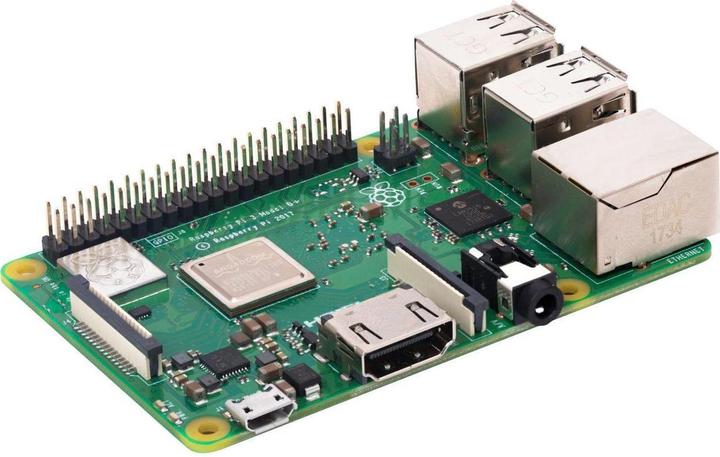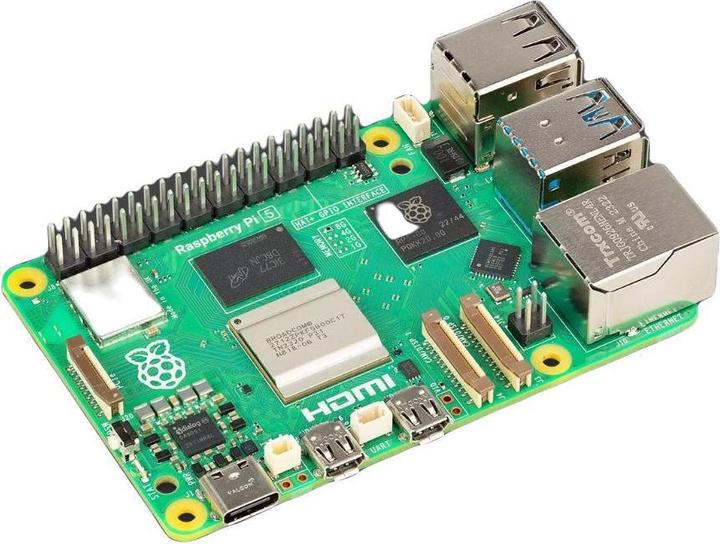
Best selling Development boards + Kits from Raspberry Pi
On this page you'll find a ranking of the best Raspberry Pi products in this category. To give you a quick overview, we've already ranked the most important information about the products for you.
1. Raspberry Pi New 5 / 8GB
The Raspberry Pi 5 8GB is a state-of-the-art development board that is perfect for a wide range of projects, from software development to building your own media centers. Equipped with a powerful Quad-Core Cortex-A76 processor and 8 GB of LPDDR4x SDRAM, this device offers outstanding performance and flexibility. The two microHDMI ports enable impressive video output, making it ideal for multimedia projects and dual-monitor setups. With two USB 3.0 and two USB 2.0 ports, the Raspberry Pi 5 provides extensive options for data transfer and connecting peripherals. Power is supplied via a modern USB-C port, ensuring a reliable energy source. Exceptional networking is facilitated by dual-band Wi-Fi, supporting both 2.4 GHz and 5 GHz, as well as Bluetooth 5.0/BLE for fast and stable connections. The Ethernet port allows for rapid data transfers at speeds of up to 1000 Mb/s, and the option to be powered via PoE (Power over Ethernet) offers additional flexibility.
Highlights:
- Built-in Quad-Core Cortex-A76 processor with a clock speed of 2.4 GHz
- Supports dual-band Wi-Fi (2.4 GHz and 5 GHz) and Bluetooth 5.0/BLE
- Two microHDMI ports for dual-monitor setups.

2. Raspberry Pi 5 16GB
The Raspberry Pi 5 with 16 GB RAM is a powerful and versatile development board that is ideal for a wide range of applications, from software development to multimedia projects. Equipped with a Quad-Core Arm Cortex-A76 processor, it offers high computing power and efficiency. Support for dual-band Wi-Fi and Bluetooth 5.0 enables seamless connectivity to networks and devices. With two micro-HDMI ports, users can connect impressive 4K displays, making it an excellent choice for visual applications. The board features a standard 40-pin GPIO interface, allowing for easy integration with various sensors and actuators. Power is supplied via an external USB-C power adapter, sold separately. This board is suitable not only for hobbyists but also for professional developers looking to create innovative solutions and projects.
- Quad-Core Arm Cortex-A76 processor with 2.4 GHz
- Dual 4Kp60 HEVC capable micro-HDMI ports
- Support for PCIe 2.0 x1 interface for fast peripherals
- Gigabit Ethernet with PoE+ support
- Two USB 3.0 ports for high data transfer rates.
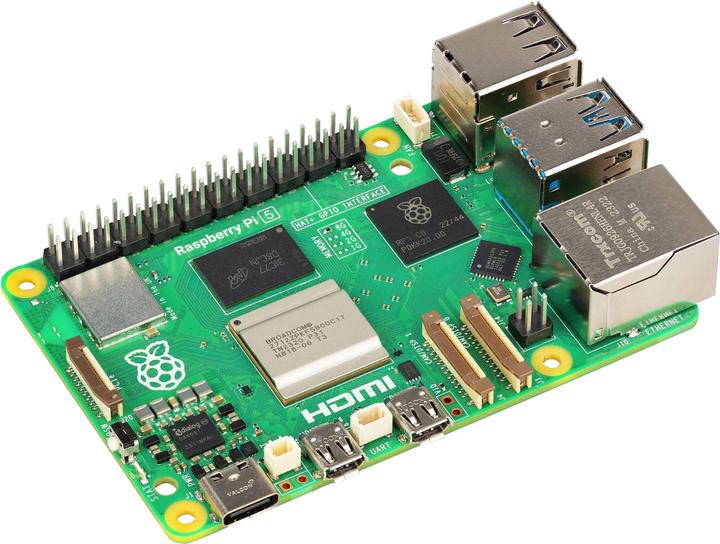
3. Raspberry Pi New 5 / 4GB
The Raspberry Pi 5 4GB is a highly advanced development board that builds on the success of its predecessor and offers a significant performance boost. Equipped with a 2.4 GHz quad-core ARM Cortex-A76 processor and 4 GB LPDDR4x SDRAM, this board delivers impressive computing power and efficiency. It supports Wi-Fi 5 (802.11ac), Bluetooth 5.0, and features a variety of interfaces, including USB 3.0, USB 2.0, and Gigabit Ethernet. The Raspberry Pi 5 is ideal for developers and tech enthusiasts who need powerful and versatile hardware for their projects.
Highlights:
- VideoCore VII GPU for enhanced graphics performance
- Support for PoE+ (Power over Ethernet)
- Integrated power button and real-time clock (RTC).

4. Raspberry Pi 4 4GB Model B
The Raspberry Pi 4 Model B is the latest computer board from Raspberry Pi. This version offers more processing power, more memory, and more connectivity while remaining backward compatible with projects created on earlier models. What is a Raspberry Pi? A Raspberry Pi is a compact computer board that offers endless possibilities. From the very beginning, the Raspberry Pi was designed to be easy to use and customizable. Simply connect a TV or monitor, a keyboard, a mouse, and a power supply, and you can get started. A Raspberry Pi is great because the device is suitable for almost all age groups. Whether you want to teach children programming or engineers want to create complex computer-controlled systems, anyone can use a Raspberry Pi. There is a wide range of "HATs" (Hardware Attached on Top) and other accessories that you can connect to the Raspberry Pi to utilize special features.
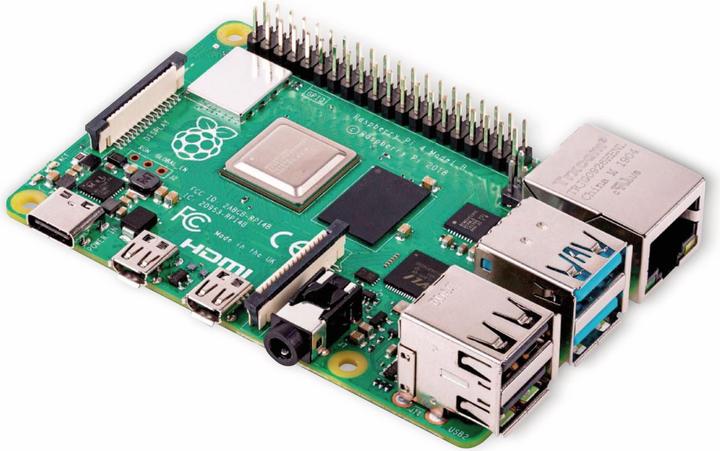
5. Raspberry Pi 4 8GB Model B
The Raspberry Pi 4 Model B is the latest computer board from Raspberry Pi. This version offers more processing power, more memory, and more connectivity while remaining backward compatible with projects created on earlier models.
What is the Raspberry Pi? A Raspberry Pi is a compact computer board that offers endless possibilities. From the very beginning, the Raspberry Pi was designed to be easy to use and customizable. Simply connect a TV or monitor, a keyboard, a mouse, and a power supply, and you’re ready to go.
A Raspberry Pi is great because the device is suitable for almost all age groups. Whether you want to introduce children to programming or engineers want to create complex computer-controlled systems, anyone can use a Raspberry Pi. There is a wide range of "HATs" (Hardware Attached on Top) and other accessories that you can connect to the Raspberry Pi to utilize special features.

6. Raspberry Pi Zero 2 W
With the same shape and retaining the same connectivity, the Raspberry Pi Zero 2 W positions itself as a worthy successor to the first generation Raspberry Pi Zero W. The Raspberry Pi Zero 2 W therefore fits into most existing Raspberry Pi Zero housings.
Building on the success of the Zero family, the Raspberry Pi Zero 2 W is built around a system-in-package developed by Raspberry Pi. This new microcomputer incorporates the BCM2710A1 chip already used in the Raspberry Pi 3 and relies on 512 MB of RAM.

7. Raspberry Pi 3 Model B
The Raspberry Pi 3 Model B is the successor to the successful mini-computer Raspberry Pi 2. Despite its extremely compact size, it represents a fully functional PC thanks to its 1.2 GHz quad-core ARMv8 processor and 1 GB of RAM. It is suitable for a variety of applications, such as serving as the basis for a web server, a media center PC, or for control tasks. The Raspberry Pi 3 Model B is also equipped with four USB 2.0 ports, a 10/100 Mbps LAN connection, as well as WLAN 802.11n and Bluetooth 4.1 with Bluetooth Low Energy. The integrated graphics feature an HDMI and an AV output and are capable of playing videos in Full HD (1080p). Sound output can also be done through either the HDMI or AV output. The Raspberry Pi 3 Model B does not have a conventional hard drive connection; instead, it features a microSD card reader, into which a memory card is inserted as the boot medium. Power is supplied via a Micro-USB port, similar to those used in modern mobile devices like smartphones or tablets. The Raspberry Pi 3 Model B is extremely energy-efficient, consuming only about 4 watts during operation.
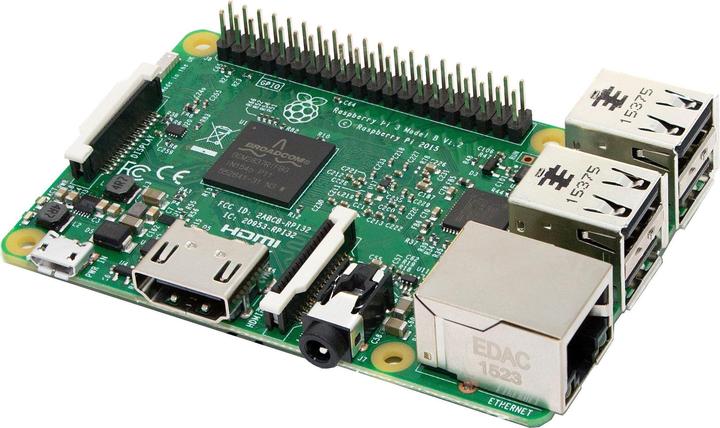
8. Raspberry Pi 5 2GB
The Raspberry Pi 5 with 2 GB RAM is a powerful and versatile single-board computer, ideal for developers, hobbyists, and tech enthusiasts. Equipped with a quad-core Arm Cortex-A76 processor, this board delivers impressive performance for a wide range of applications, from software development to multimedia projects. Support for dual-band Wi-Fi and Bluetooth 5.0 enables seamless wireless connectivity, while the two micro-HDMI ports allow for 4K output at 60 frames per second. With the standard 40-pin GPIO interface, users can connect a variety of peripherals and sensors, making the board an excellent choice for IoT projects. The Raspberry Pi 5 is not only compact and lightweight but also energy-efficient, making it a practical solution for many technical challenges.
- Quad-core Arm Cortex-A76 processor with a clock speed of 2.4 GHz
- Support for dual-band 802.11ac Wi-Fi and Bluetooth 5.0
- Two 4Kp60 HEVC-capable micro-HDMI ports
- Standard 40-pin GPIO interface for expanded functionality
- Compatible with a variety of operating systems and software tools.
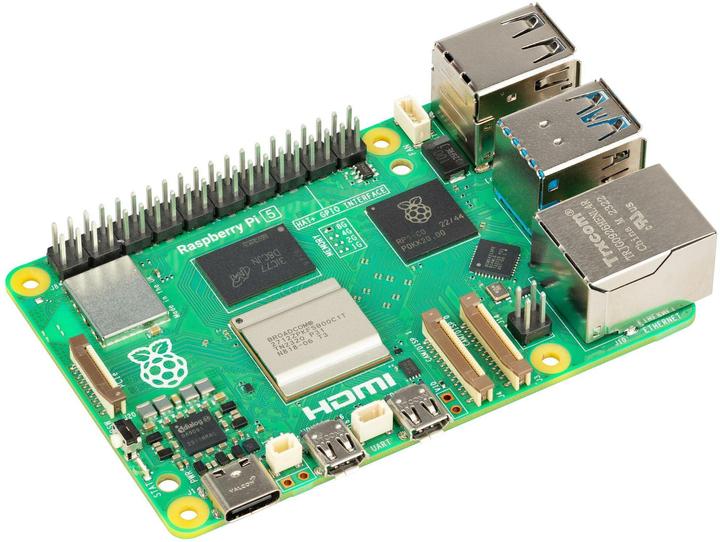
9. Raspberry Pi Pico 2W
The next generation Raspberry Pi microcontroller board, built with RP2350. Just as good, but better. With a higher core clock speed, twice the memory, more powerful Arm cores, optional RISC-V cores, new security features and improved interface functions, the Raspberry Pi Pico 2W offers a significant performance boost while maintaining compatibility with earlier members of the Raspberry Pi Pico series. Programmable in C/C++ and Python and with extensive documentation, the Raspberry Pi Pico 2W is the ideal microcontroller board for enthusiasts and professional developers alike.
The chip from the new block. The Raspberry Pi Pico 2W is powered by the RP2350, the new powerful and secure microcontroller. Every aspect of the design has been improved, from the CPU cores to the unique PIO interface subsystem. New low-power states and housing options expand the range of addressable applications.
Switch on. The RP2350's unique dual-core and dual-architecture capability allows users to choose between an industry-standard pair of Arm Cortex-M33 cores and an open-hardware-standard pair of Hazard3 cores. This gives developers the opportunity to experiment with the RISC-V architecture in a stable, well-supported environment.
Radical transparency. The RP2350's security architecture, including the secure boot ROM, is fully documented and fully available to all users. This transparent approach, in contrast to the security by obscurity offered by older suppliers, allows professional users to integrate the RP2350 and Raspberry Pi Pico 2 into products with confidence.
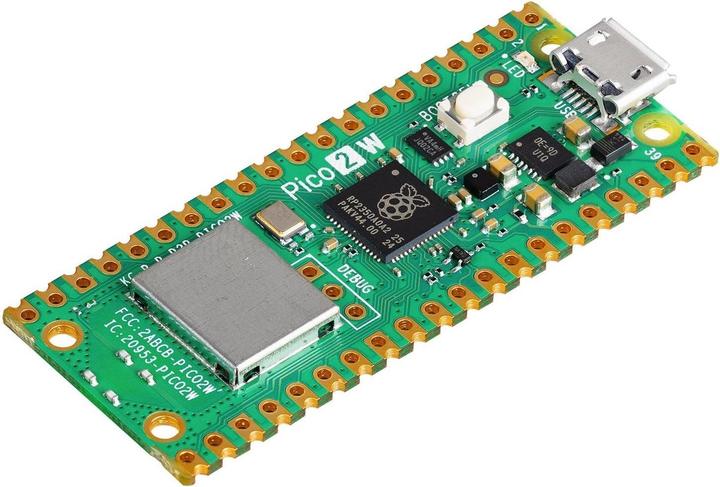
10. Raspberry Pi 3 Model B+
The new B+ board has the same dimensions as the previous B model and the Raspberry Pi 2. This allows it to be used as an upgrade for existing projects and even in most existing cases. The new B+ model offers improved board components to support your applications and for faster, more reliable computations. The B+ also features a powerful 64-bit quad-core processor that is at least 10% faster than the previous model. The heat management has also been enhanced. If you want great speed and connectivity, the Raspberry Pi 3 Model B+ is just right for you. Whether you want to learn programming or try to integrate IoT (Internet of Things) at your workplace, the B+ model will help you achieve your goals. It is impossible to list all the features of a Raspberry Pi. With add-ons, the only limit is your imagination. The Raspberry Pi covers a vast range of applications - it can be used as a media player, for IoT integration, in education, for gaming, for monitoring working conditions and productivity, and even for controlling your own robot.
